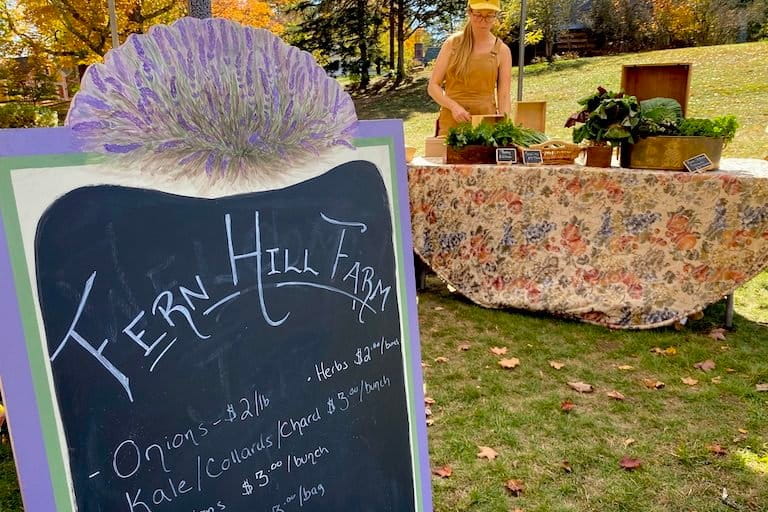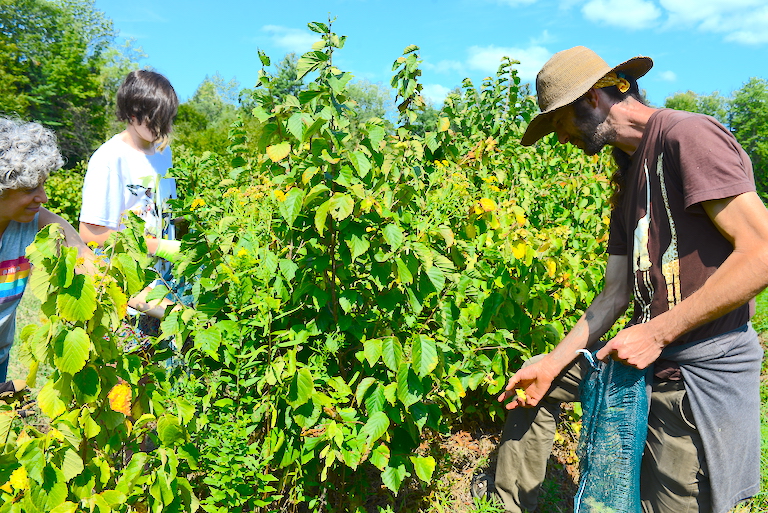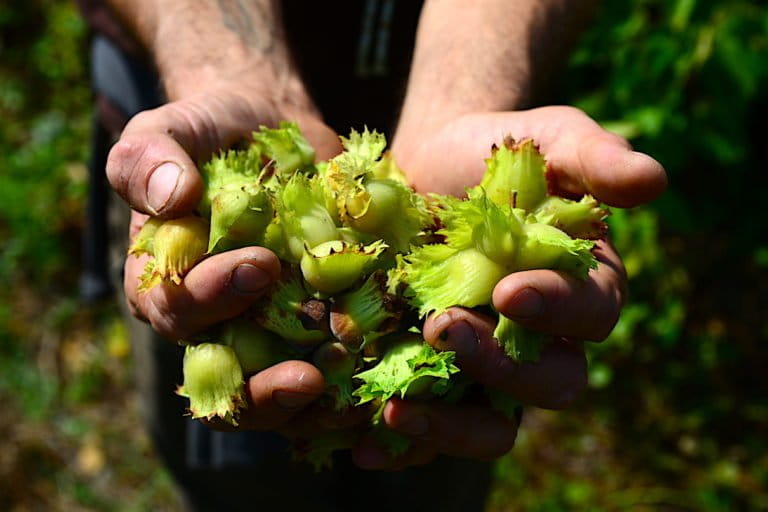- “There is a windfall of federal money entering the agroforestry sector. After 30-plus years of work on agroforestry in the United States, the sector’s moment has arrived,” a source tells Mongabay.
- In mid-September, USDA unveiled the Partnerships for Climate-Smart Commodities funding program, investing up to $2.8 billion in 70 projects, which includes over $60 million to advance agroforestry.
- Agroforestry is the most climate-conscious form of agriculture, sequestering an estimated 45 gigatons of carbon globally while providing habitat for biodiversity, boosting water tables, and building soil.
- This intentional combination of woody perennials like shrubs and trees with annual crops like grains and vegetables also increases farms’ resilience to drought, heat, and deluges, by providing shade, windbreaks, and deep root systems capable of absorbing excess water.
Recent months have delivered a harvest of agroforestry funding news in the U.S., just as the season’s remaining crops ripened. The announcement of over $60 million in support from the Department of Agriculture (USDA) in particular has stoked enthusiasm for this sustainable agriculture technique that also sequesters carbon and boosts biodiversity.
“There is a windfall of federal money entering the agroforestry sector,” Meghan Giroux told Mongabay. The director of Vermont-based agroforestry consultancy Interlace Commons, she is currently implementing a program to boost regional training capacity toward helping farms implement this sustainable farming technique – which blends annual crops and livestock with perennial shrubs and trees in a carbon-sequestering system that’s also more resilient to droughts and floods – while keeping her eye on the sizable new opportunities coming from the federal government.
That federal funding comes as interest in agroforestry is growing rapidly in the U.S. alongside the need to rapidly adopt more climate-positive types of agriculture: though Giroux’s current project is funded by a private foundation, people like her see a myriad of funding opportunities and even more enthusiasm among people seeking training and support to implement it.

Lindsay Allen of Buckland, MA, is a good example. Her Fern Hill Farm is one of many currently receiving support from Interlace Commons to implement an agroforestry system where annual crops will be grown among rows of closely planted nut and berry cultivars.
“I’ve been farming for 12 years, but it’s not been agroforestry-focused, so to have the advice of someone like Meghan is excellent,” Allen told Mongabay between helping customers at her busy farmer’s market booth in neighboring Ashfield.
Many other farmers like her stand to gain from the USDA’s mid-September unveiling of the Partnerships for Climate-Smart Commodities (CSC) program, investing up to $2.8 billion in 70 projects. One of these 70 is a $60 million project to advance agroforestry, and is administered by The Nature Conservancy, which will distribute funds to local and regional for-profit and nonprofit training and support partners – from Alabama to Maine, Minnesota to Hawaii and Texas – 37 states in all.
One of the partners in their “Expanding Agroforestry Production and Markets” program to advance agroforestry systems for nut, fruit, and grass-fed beef production is Wisconsin-based Savanna Institute.

“We are honored and grateful to be among this incredible group of organizations and businesses who are committed to mitigating climate change,” said Keefe Keeley, director of the nonprofit which is a leading agroforestry training and research provider in the Midwest on techniques like alley cropping of hazelnuts (Savanna is also a partner in a program of Organic Valley which was awarded $25 million by the CSC, a portion of which is also earmarked for agroforestry).
Agroforestry sequesters two to five tons of carbon per acre per year, TNC estimates, and their Joe Fargione adds that the level of adoption expected from this project would generate carbon sequestration of 1-2.5% of 2020 U.S. emissions from all sources, and over 20 years, the project could help farmers develop 80 million acres of high-density agroforestry, mitigating 3-6% of the country’s 2020 emissions.
For-profits including Propagate Ventures, which helps farms transition from conventional crops to agroforestry while turning a profit, are also part of the mix on the project.
Audrey Epp Schmidt, director of strategic partnerships for Propagate, said “This funding will catalyze significant private investments into the industry and increase farmers’ incomes while simultaneously expanding carbon sequestration, soil health, biodiversity, and water quality.” And it comes at the same moment that the firm announced its own funding news: the successful raising of $10 million in private capital to support its work helping farms transition their acreage to agroforestry.
See related: Investors say agroforestry isn’t just climate friendly — it’s also profitable

Only about 1.5% of U.S. agriculture is classified as agroforestry according to a recent analysis by USDA’s National Agroforestry Center (NAC), so technical assistance and farmer outreach efforts like the TNC-administered project – which is forecast to bring 30,000 acres under that umbrella in the next five years – would boost its scaling up across the country.
NAC has fresh leadership for that scaling effort, too. Anne Marsh was recently appointed as its new director:
“The National Agroforestry Center will continue to support USDA agencies that have technical and financial assistance programs for farmers. That support comes in the form of new research on benefits, costs, and implementation considerations that can be incorporated into programs to make connections to agroforestry opportunities more visible,” Marsh told Mongabay by email. “The Center will also develop new decision-making tools for technical support staff and farmers, and provide training to USDA staff and a growing number of non-federal partners to increase the delivery of agroforestry-related services.”
That emphasis on further training of USDA staff to train farmers will be welcomed by the agroforestry community, whose many adherents have generally not waited for government training or support to expand, but have instead plunged into it independently.

Nutwood Farm established a still-maturing two-acre hazelnut alley cropping system on a seven-acre former Christmas tree farm in Cummington, MA – via a mixture of crowd-funding, a small Sustainable Agriculture Research & Education (SARE) grant, plus great personal effort – and is a good example.
“We’re small, but we want to show it’s possible,” Nutwood co-owner Seva Water told Mongabay during a recent harvest party, where volunteers working among the hazelnut alleys – between which sheep will eventually be grazed, making it a mixed alley cropping and silvopasture site – helped bring in 900 pounds of fresh nuts, which will yield about 200 pounds of kernels when dried.
Would training still be useful to growers like her? “Technical assistance is needed at all parts of the value chain, especially for the harvesting and processing of key perennial crops like hazelnuts,” Water said. “There are still many bottlenecks to overcome to advance temperate agroforestry in the Northeast, but as always, it’s the small farms that are leading the way.”
See also: New road map for expanding chestnut agroforestry in the U.S.

Because local USDA office staffers generally don’t offer such technical agroforestry training, that gap is something which programs like Interlace Agroforestry aim to close. Until then, aspiring agroforesters can start their search at the NAC’s training resources page or the USDA’s Natural Resource Conservation Service (NRCS), which plays a role, too, by offering webinars for landowners, and several agroforestry practices are listed among the NRCS’s Climate-Smart Mitigation Activities for 2022.
While the millions in funding from the CSC is at the center of this current surge in interest, the recently passed Inflation Reduction Act also contains climate provisions that could provide indirect support for agroforestry, since its funding will likely support existing USDA programs that come under the climate-smart agriculture banner.
As technical assistance capacity continues to expand via these public and private programs, can aspiring growers gain the knowledge and support they need to get going, now? Interlace’s Megan Giroux thinks so.

“After 30-plus years of work on agroforestry in the United States, the sector’s moment has arrived. It’s a blessing and a curse because on the one hand, our sector has never seen this level of commitment to agroforestry,” Giroux said. “On the other, we are still woefully unprepared, without enough service providers appropriately equipped to train farmers in the modern forms of agroforestry.”
The coming months and years, then, will be crucial to harness this new commitment and enhance training to increase agroforestry’s implementation across the U.S., toward greater climate resilience of the nation’s agriculture.
Erik Hoffner edits Mongabay’s series on agroforestry, find his latest thoughts at Bluesky via @erikhoffner or at Instagram.
Related audio from Mongabay’s podcast: Agroforestry is an ancient climate change solution developed by Indigenous communities over millennia which boosts food production and biodiversity, and is now being adopted widely around the world, listen to a discussion with three guests here:
See related coverage:
Nuts about agroforestry in the U.S. Midwest: Can hazelnuts transform farming?
